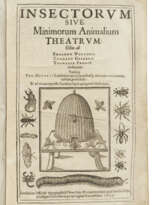ID 993355
Lot 141 | MOFFET, Thomas (1553-1604)
Estimate value
£ 2 500 – 3 500
Insectorum sive minimorum animalium theatrum. London: ex officina typographica Thom. Cotes. Et venales extant apud Giuliel. Hope, ad insigne chirothecae, propre regium excambium, 1634
First edition, second issue of the earliest entomological book published in England. When it appeared in 1634, the Insectorum was the most accurate study on invertebrates and set a new standard, by systematically analysing their habits, habitat, breeding and economic importance. Apart from Wotton’s own work, which derived from his direct observation during his European travels, the book relied on the research of three other naturalists: Conrad Gesner (1516-1565) of Zurich, Thomas Penny (c.1532-1588) of Gressingham, Lancashire, and Edward Wotton (1492-1555) of Oxford. When Gesner died, he left among his papers an unfinished book on insects, which was eventually sold to his assistant Penny. Penny also acquired the entomological notes of Wotton, and had made some progress in combining Gesner’s and Wotton’s information before his death in 1589. Penny’s manuscript passed to his friend and neighbour Thomas Moffet, who completed it, had an engraved title (dated 1589) made for it by the engraver William Rogers (fl.1584-1604), and began negotiating for its publication at The Hague. Moffet’s negotiations apparently fell through, however, and the book was still in manuscript at his death. The Insectorum was published 30 years after Moffet’s death by Sir Theodore Mayerne (1573-1655), who having purchased the manuscript from Moffet’s apothecary Darrell, added a dedication to the royal physician Sir William Paddy (1554-1634), but did not alter the text. To reduce costs, the book appeared with woodcuts rather than engraved illustrations, and without Rogers’s engraved title. Species were not given names but only differentiated by short descriptive paragraphs; numerous woodcuts, ‘crude’ but ‘perfect intelligible to anyone tolerably skilled in the science of entomology’, facilitate the determination (Lisney p.7). Lisney identifies three issues of Insectorum, distinguished by their imprints: the imprint of the first issue reads ‘Ex officina typographica Thom. Cotes. Et venales extant apud Benjam. Allen...’; that of the second issue reads ‘Ex officina typographica Thom. Cotes. Et venales extant apud. Guiliel. Hope...’; and the third issue’s imprint simply states ‘Ex officina typographica Thom. Cotes’. Garrison-Morton 288; Lisney pp.4-9; Nissen ZBI 2852; Norman 1528.
Folio (305 x 195mm). Large woodcut on title surrounded on three sides by various insects, 4 pages of woodcuts of insects at end, numerous woodcuts in text of hundreds of varieties of insects and small creatures (clean copy with minimal staining, A1 with lower corner torn away without loss of text, a1 with upper corner torn away without loss of text, C2 with small hole, tiny and very marginal worm hole to lower corner of A2-a3, D4-Y1). Contemporary calf, the boards panelled in blind, spine blind tooled in 6 compartments with raised bands (lower joint cracked at foot and rear cover slightly warped). Provenance: Sir Alexander Ramsay of Balmain, Baronet (armorial bookplate).
Special notice
This lot is offered without reserve. No VAT is payable on the hammer price or the buyer's premium for this lot. Please see the VAT Symbols and Explanation section of the Conditions of Sale for further information
| Artist: | Thomas Moffet (1553 - 1604) |
|---|---|
| Place of origin: | Northern Europe, Europe, United Kingdom |
| Auction house category: | Printed books |
| Artist: | Thomas Moffet (1553 - 1604) |
|---|---|
| Place of origin: | Northern Europe, Europe, United Kingdom |
| Auction house category: | Printed books |
| Address of auction |
CHRISTIE'S 8 King Street, St. James's SW1Y 6QT London United Kingdom | |
|---|---|---|
| Preview |
| |
| Phone | +44 (0)20 7839 9060 | |
| Buyer Premium | see on Website | |
| Conditions of purchase | Conditions of purchase |






